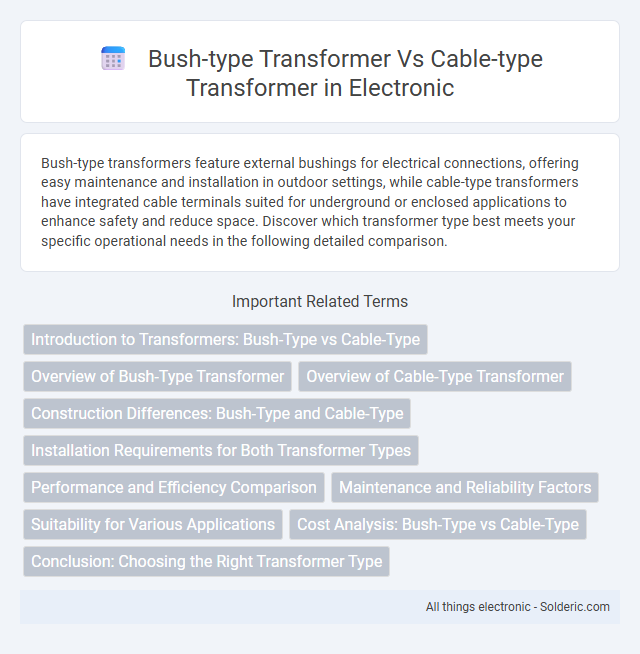Bush-type transformers feature external bushings for electrical connections, offering easy maintenance and installation in outdoor settings, while cable-type transformers have integrated cable terminals suited for underground or enclosed applications to enhance safety and reduce space. Discover which transformer type best meets your specific operational needs in the following detailed comparison.
Comparison Table
| Feature | Bush-Type Transformer | Cable-Type Transformer |
|---|---|---|
| Design | Uses bushings for cable connections | Direct cable connection without bushings |
| Installation | Requires external bushings, simpler cable handling | Integrated cable termination, more complex installation |
| Cost | Generally lower initial cost | Higher cost due to integrated cable system |
| Maintenance | Easier to maintain bushings separately | Maintenance involves entire cable assembly |
| Reliability | Good, but bushings can be failure points | Higher reliability with fewer connection points |
| Applications | Suitable for standard substations and installations | Best for compact urban substations and underground systems |
Introduction to Transformers: Bush-Type vs Cable-Type
Bush-type transformers feature external bushings for high-voltage connections, enabling easier maintenance and visual inspection, while cable-type transformers have integrated cable terminations suited for compact urban installations with limited space. Bush-type transformers are commonly used in substations where accessibility and outdoor mounting are essential, contrasting with cable-type transformers designed for underground distribution networks requiring waterproof and space-efficient solutions. Both types serve critical roles in electrical power distribution, with their design optimized for specific operational environments and installation constraints.
Overview of Bush-Type Transformer
Bush-type transformers feature external high-voltage bushings that connect the transformer core to the external circuit, enabling easy access for maintenance and installation. Their design typically allows for straightforward cooling and excellent dielectric performance, making them suitable for high-voltage applications. You can benefit from their modular structure, which enhances flexibility and reliability in power distribution systems.
Overview of Cable-Type Transformer
Cable-type transformers are compact electrical devices designed to integrate directly into underground power cable networks, improving space efficiency and reducing installation complexity compared to bush-type transformers. They feature encapsulated windings and insulation systems optimized for underground applications, providing enhanced protection against environmental factors and minimizing maintenance requirements. These transformers are widely used in urban distribution systems to optimize reliability and reduce visual impact within confined spaces.
Construction Differences: Bush-Type and Cable-Type
Bush-type transformers feature external bushings for high-voltage cable connections, enabling easier maintenance and visual inspection, whereas cable-type transformers integrate cable terminations directly within sealed compartments, enhancing compactness and reducing external exposure. Bush-type designs often use porcelain or composite bushings protruding from the tank, while cable-type transformers employ molded or gland cable accessories sealed into tanks or cable boxes. The construction differences impact installation space requirements, durability in harsh environments, and ease of fault detection in power distribution networks.
Installation Requirements for Both Transformer Types
Bush-type transformers require robust bushings and secure mounting points, often demanding more space and complex insulation systems during installation. Cable-type transformers feature integrated cable connections designed for flexibility and compactness, enabling easier trench or duct installation with minimal clearance. Installation of cable-type transformers generally requires fewer ancillary components and is well-suited for confined urban environments, while bush-type transformers are preferred in substations with ample space and higher voltage ratings.
Performance and Efficiency Comparison
Bush-type transformers exhibit high efficiency with minimal energy losses due to their simple, robust design and excellent cooling capabilities. Cable-type transformers provide superior performance in compact spaces, offering enhanced electrical insulation and reduced electromagnetic interference, which can improve reliability in densely packed urban installations. When choosing your transformer, consider bush-type models for cost-effective efficiency and cable-type units for optimal space utilization and electrical performance.
Maintenance and Reliability Factors
Bush-type transformers typically require more frequent maintenance due to exposed bushings that are susceptible to environmental contaminants and physical damage, impacting reliability in harsh conditions. Cable-type transformers offer enhanced reliability with enclosed, insulated connections that reduce exposure to moisture and airborne particles, minimizing maintenance needs. Your choice should consider the operational environment and maintenance capabilities to ensure optimal transformer performance and longevity.
Suitability for Various Applications
Bush-type transformers are ideal for outdoor installations and high-voltage applications due to their robust design and ease of maintenance, while cable-type transformers excel in indoor or space-constrained environments where compactness and insulation are critical. Your choice depends on the specific installation site, voltage requirements, and space availability, with bush-type transformers providing better accessibility for inspection and repairs. For urban or underground settings, cable-type transformers offer superior protection against environmental factors and reduced electromagnetic interference.
Cost Analysis: Bush-Type vs Cable-Type
Bush-type transformers generally have lower initial costs due to simpler installation and lighter components, making them suitable for standard applications with limited budget constraints. Cable-type transformers tend to incur higher expenses because of their advanced insulation systems and robust construction, which provide improved safety and durability in harsh environments. Your choice should weigh the upfront investment against long-term operational reliability and maintenance costs to optimize overall cost-efficiency.
Conclusion: Choosing the Right Transformer Type
Selecting the right transformer type depends on your specific application requirements, space constraints, and environmental factors. Bush-type transformers offer easier maintenance and flexibility for indoor installations, while cable-type transformers provide enhanced insulation and reliability, especially in underground or compact spaces. Understanding these key differences ensures you optimize performance, safety, and longevity in your electrical system.
bush-type transformer vs cable-type transformer Infographic

 solderic.com
solderic.com